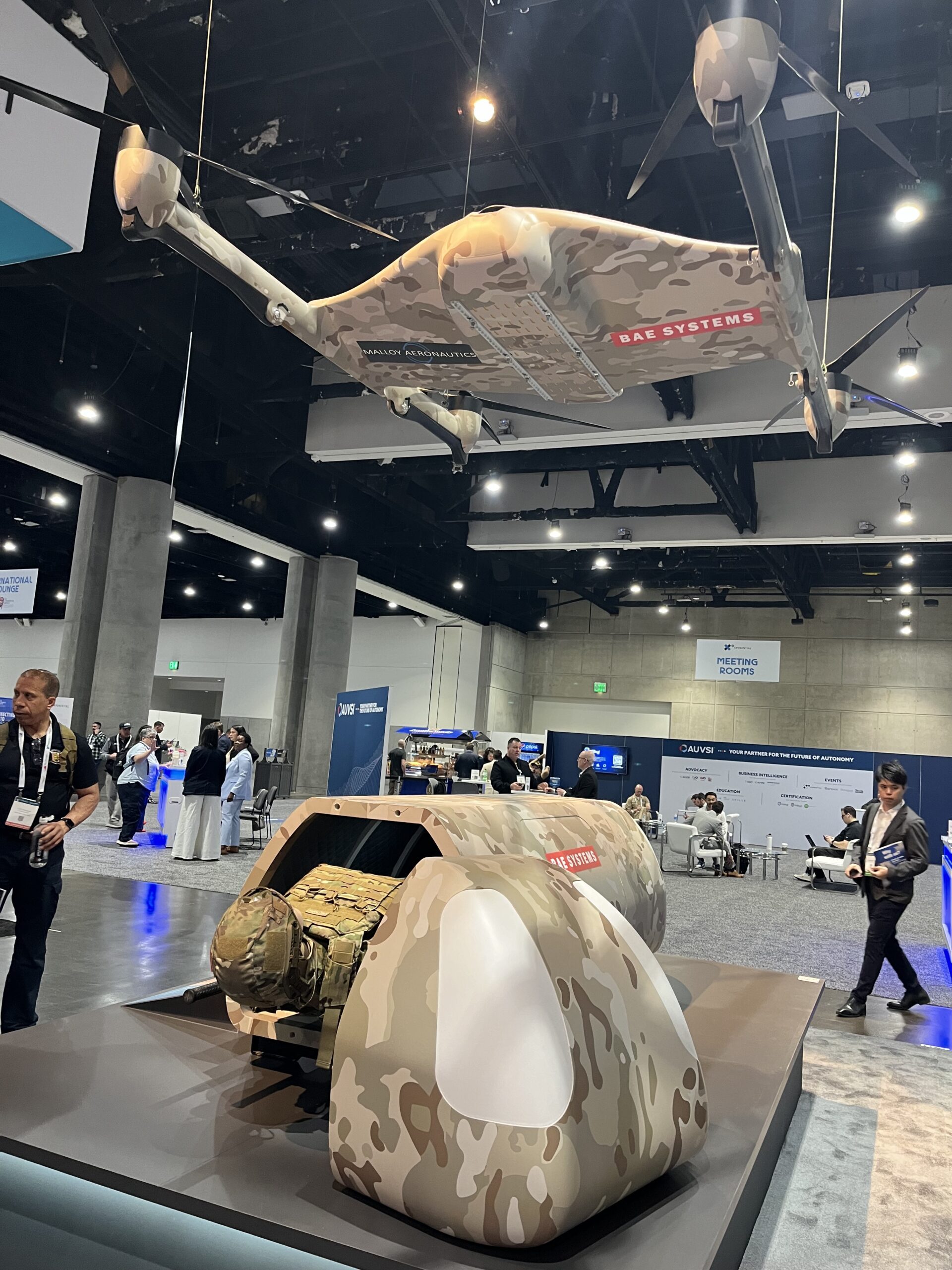 Advancing Defense Innovation: Defense Innovation Unit 3.0 Focuses on Rapid Deployment of Commercial Technologies
Advancing Defense Innovation: Defense Innovation Unit 3.0 Focuses on Rapid Deployment of Commercial Technologies
By DRONELIFE Contributor Dawn Zoldi (Colonel USAF, Ret.)
In the realm of defense innovation, XPONENTIAL shined a spotlight on operationalizing DIU 3.0. A fireside chat discussion between Doug Beck, Director of the Defense Innovation Unit (DIU), and Courtney Albon of Defense News & C4ISRNet, dug deeply into how this initiative signals a significant shift in how defense leaders approach arming warfighters with the latest proven and mature commercial technologies. With an emphasis on expedited deployment as the landscape of warfare and security evolves, these innovations will address critical capability gaps to usher in a new era of defense readiness and effectiveness. Read on to learn more about the continuous evolution of DIU’s approach, from its inception through the future.
The 3 Lenses
Beck’s unique background, spanning 13 years as a former Vice President at Apple, as one of the originators of DIU and 27 years in the US Navy Reserve (culminating in the rank of Captain), which he called “his three lenses” to now lead DIU 3.0.
Having been instrumental in the standing up of the original organization dubbed DIUx under Ash Carter’s directive to harness the power of the commercial tech sector, Beck brings a wealth of experience in integrating commercial technologies into military operations.
His time at Apple inspires his commitment to leveraging proven, mature commercial technologies to address strategic challenges in areas such as AI, autonomy, cyber, energy, telecom, space and biotech.
Beck’s extensive involvement in the Indo-Pacific region further informs his leadership perspective, emphasizing the importance of understanding the geopolitical landscape and regional dynamics.
With a sense of urgency underscored by the evolving security environment, Beck recognizes the imperative to capitalize on this capability now, especially with the support of key stakeholders in the Department of Defense, Congress and the tech sector and leverages this background and experience to lead DIU into the future.
 The Evolution
The Evolution
Since its inception in 2015, DIU has undergone significant evolution marked by transformation since its initial establishment as DIUx (1.0) to its current iteration as DIU 3.0.
In its nascent stages, DIUx focused on bridging the gap between the worlds of defense and commercial technology, to bridge the lack of integration between the two spheres.
Fast forward to the present, DIU has progressed significantly, both in terms of its operational capabilities and its collaboration with the commercial sector. Through its 2.0 phase, spanning from roughly 2016 to 2017, DIU demonstrated its capacity to rapidly address real military challenges by leveraging commercially-derived technology and existing authorizations in innovative ways. It delivered tangible solutions to warfighters in a matter of months rather than years. While its achievements are commendable, Beck noted, they are not sufficient to meet the strategic imperatives of today’s security landscape.
With DIU 3.0, Beck has shifted focus towards applying this proven capability to strategically significant operational gaps to ensure scalability and impactful outcomes. DIU has evolved into a direct report entity to elevate its importance and leverage an ability to work across Service lines. DIU’s mission, however, remains steadfast: to deliver solutions that enable victory on the battlefield and uphold national security objectives, Beck said.
5 Strategic Lines Effort
The DIU 3.0 strategy published last August outlined five key lines of effort aimed at scaling the organization’s impact. Beck explained how his team continues implementing it.
First, DIU embeds deeply with the warfighter to actively shape technology implementation strategies in collaboration with entities like the Joint Mission Accelerator Director. This approach facilitates a nuanced understanding of operational needs and fosters direct engagement with DIU personnel.
Second, DIU continues working to scale across the Department of Defense (DOD) by forging deep partnerships with services, Joint Staff, and OSD partners to accelerate innovation. For example, initiatives such as Replicator aim to expedite processes by leveraging existing structures, such as the Strategic Capabilities Office in the Navy.
Third, DIU coordinates with various agencies and partners to synergize efforts and overcome barriers that hinder the adoption of commercial technologies. This collaborative approach ensures a cohesive ecosystem conducive to impactful outcomes.
Fourth, DIU remains committed to streamlining engagement with the tech industry to provide clearer pathways and insights into opportunities and risks. This, Beck noted, will facilitate scalable investments in DIU initiatives.
Finally, DIU emphasizes deep partnerships with allies and partners. Beck recognizes the importance of collective efforts in addressing shared challenges.
Through these concerted efforts, DIU has already built trust and advanced its mission significantly within Beck’s first year in the DIU head chair.
Money for the Mission
 With nearly 1 billion dollars allocated by Congress for DIU 3.0, Doug Beck continues to navigate the challenge of swiftly putting this funding to work to execute the mission. Understanding that this financial support underscores the trust vested in DIU, Beck and his team have approached it with utmost seriousness by collaborating closely with Congress to ensure effective execution.
With nearly 1 billion dollars allocated by Congress for DIU 3.0, Doug Beck continues to navigate the challenge of swiftly putting this funding to work to execute the mission. Understanding that this financial support underscores the trust vested in DIU, Beck and his team have approached it with utmost seriousness by collaborating closely with Congress to ensure effective execution.
Beck said his team’s strategy revolves around prioritization, focusing on endeavors that promise genuine strategic impact, whether it’s deterring conflict or securing victory in combat situations. Beck explained that he has allocated funding across four major areas for maximum impact: expanding and accelerating ongoing strategic initiatives, integrating strategic enhancements with existing technology, reinforcing partnerships with entities like AFWERX and SPACEWORX and focusing on more joint efforts, and driving critical system efforts to lower barriers of entry, such as cybersecurity standards. While Beck would not announce any big budget reveals, the effort he outlined provided promise of substantial activity and progress across many key areas. He said that DIU was going to “just get after it” and deliver results.
Replicating Success
Following the announcement by Deputy Secretary Hicks last August about the Replicator program, Beck said Replicator 1.0 has made substantial strides in achieving its objectives. With a primary goal of swiftly providing attritable autonomous capabilities to the warfighter within 18-24 months at scale, with a focus on autonomous technology, Replicator 1.0 has demonstrated its efficacy in breaking down barriers to scalability.
Operating under the governance structure established by the Deputies Innovation Steering Group, where DIU plays a pivotal role as lead of the Innovation Working Group, Replicator 1.0 has streamlined decision-making processes to enable rapid progress. This governance structure includes the Combatant Commands (COCOMS) and Joint Staff with the Office of the Secretary of Defense (OSD). “This is about doing things in parallel instead of serially,” Beck said.
Leveraging existing initiatives like Commercial Services Openings (CSOs), this cross-cutting team successfully completed the first tranche of system decisions before the end of 2023. The team is currently on track to advance into its second tranche “to deliver that new muscle.”
Replicator 1.0 remains poised to keep delivering a range of off-the-shelf and newer technologies to the warfighter within an accelerated time frame. Breaking through traditional barriers, the Replicator team has achieved some milestones that would typically take the Department 2-3 years, in just over a month.
This progress has fueled DIU’s commitment to institutionalize this approach for future iterations. “There will be a Replicator 2, 3, 3 down the road,” Beck announced.
Blue UAS
Blue UAS, operating at the intersection of autonomy and unmanned systems across air, water, surface, and underground domains, represents one of DIU’s most dynamic initiatives to drive autonomous innovation and capability enhancement.
Beck elaborated on one notable success story within this realm, the Lionfish. A project that originated from a Commercial Services Opening (CSO) in 2019, it initially focused on collaborating with Navy PEO Unmanned to develop a small undersea vehicle to replace the Mark18 Mod 1 for critical countermine operations, Lionfish has since evolved into a multifaceted endeavor. Following the Navy’s award of the first Other Transaction Authority (OTA) to program contract, Lionfish expanded into a separate software stream, with the aim of enhancing search and avoidance capabilities. Through close collaboration, DIU’s Autonomy and Artificial intelligence (AI) groups, along with relevant Navy teams, compressed the development timeline dramatically from six months to just six days. This, Beck said, exemplifies the power of synergistic efforts in technological advancement.
Another cornerstone of Blue’s mission is the establishment of a comprehensive Blue UAS Framework for policy-compliant uncrewed systems. Launched in 2020, this framework initially comprised a pre-cleared list of systems compliant with departmental policies. Beck indicated there are now 30 individual components on the Blue UAS Framework, from software to radios and cameras.
Blue has since expanded its scope. At XPO, it announced a groundbreaking new process to incorporate certified components from the AUVSI Green UAS Framework into the Blue UAS list. This initiative not only reflects Blue UAS’s dedication to fostering interoperability and standardization but also highlights its responsiveness to evolving operational demands.
With a continuous focus on software monitoring and resilience, exemplified by projects like resilient communications for UAS in SOCOM, Blue remains positioned as a catalyst for enhancing uncrewed system capabilities across various mission sets.
According to Beck, the Framework will undergo a full refresh this fall. In the meantime, Blue UAS remains committed to expanding capabilities, reducing costs, and fostering increased scalability. “We want to increase scale and give more opportunity for more folks to be on the list,” Beck explained. “This is important for all of us.”
Final Thoughts
“This is important for all of us,” Beck said in conclusion. “When I got home from Iraq and Afghanistan, I had the biggest ah ha moment.” He explained that innovators in the DOD need to take on some reputation risk and process risk to move forward. Failing to do so will result in simply transferring risk to our soldiers, sailors, airmen and marines, which is unacceptable. We need to take that kind of risk to avoid the fatal kind of risk to our people and our nation. And Beck remains committed to do just that.
Read more:
- AUVSI and DIU Sign MOU on Drone Cybersecurity
- Reflecting on AUVSI Xponential 2024: Key Insights and Future Directions in Autonomous Vehicle Technology
- How Much Will the U.S. Department of Defense Spend on Drones in 2023? AUVSI’s Report
 Dawn M.K. Zoldi (Colonel, USAF, Retired) is a licensed attorney with 28 years of combined active duty military and federal civil service to the U.S. Air Force. She is the CEO & Founder of P3 Tech Consulting and an internationally recognized expert on uncrewed aircraft system law and policy. Zoldi contributes to several magazines and hosts popular tech podcasts. Zoldi is also an Adjunct Professor for two universities, at the undergraduate and graduate levels. In 2022, she received the Airwards People’s Choice Industry Impactor Award, was recognized as one of the Top Women to Follow on LinkedIn and listed in the eVTOL Insights 2022 PowerBook. For more information, follow her on social media and visit her website at: https://www.
Dawn M.K. Zoldi (Colonel, USAF, Retired) is a licensed attorney with 28 years of combined active duty military and federal civil service to the U.S. Air Force. She is the CEO & Founder of P3 Tech Consulting and an internationally recognized expert on uncrewed aircraft system law and policy. Zoldi contributes to several magazines and hosts popular tech podcasts. Zoldi is also an Adjunct Professor for two universities, at the undergraduate and graduate levels. In 2022, she received the Airwards People’s Choice Industry Impactor Award, was recognized as one of the Top Women to Follow on LinkedIn and listed in the eVTOL Insights 2022 PowerBook. For more information, follow her on social media and visit her website at: https://www.

Miriam McNabb is the Editor-in-Chief of DRONELIFE and CEO of JobForDrones, a professional drone services marketplace, and a fascinated observer of the emerging drone industry and the regulatory environment for drones. Miriam has penned over 3,000 articles focused on the commercial drone space and is an international speaker and recognized figure in the industry. Miriam has a degree from the University of Chicago and over 20 years of experience in high tech sales and marketing for new technologies.
For drone industry consulting or writing, Email Miriam.
TWITTER:@spaldingbarker
Subscribe to DroneLife here.







[…] the DIU’s Blue sUAS record has made it simpler for some platforms to be bought by authorities companies, some NDAA-compliant […]